LABS timber specialists are trained by Wykamol to their specially designed timber treatments when it comes to wood infestation. The traditional building methods combined with a predominantly damp, temperate climate causes the UK housing stock to suffer from a high risk from insect and fungal attack to structural timbers. A good practice in building design to pre-treat timber with preservatives as a lifetime precaution against dry rot or woodworm.
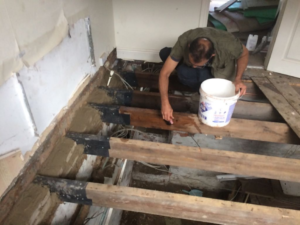
Most traditional and modern buildings unforunately do not have the benefit of such protection. Combine the lack of timber treatment with poor maintenance. This leads to many cases of timber decay identified during housing surveys. LABS surveyors are fully qualified and insurance to provide surveys for mortgage lenders.
Timber Treatment Products
LABS supply Timber Treatment Products manufactured by Wykamol Group. One of the more well known quality products includes Woodworm Treatment Products and Dry Rot Treatments. Since 1934 the products are recognised across the industry as providing high levels of protection over many years. The products are manufactured under an ISO900:2008 quality management system and are approved for use by the HSE.
The timber treatment Product ranges includes Microtech a unique microemulsion which gives 1 hour re-entry time and the Wykabor range of products based on disodium octaborate. In addition our Wykamol Plus and Woodtreat Paste are longstanding, effective products which are industry benchmarks.
In addition, LABS supply Wykamol produced range of Industrial Timber Treatments into the pre-treatment and joinery markets. Along with our own product formulations such as Wykabor Wood Preservative and Wykabor DB we are also suppliers of the Dr. Wolman range of timber preservation products for the pre-treatment and joinery industries.
To complement the timber treatments made by the Wykamol Group, they also sell a complete range of timber repair products for the remedial repair of timbers. Along with the Protimeter range of survey equipment and a complete range of installation equipment. LABS can provide you with the Wykamol products for all your needs with the timber treatments and repair.
For the householder, LABS are part of the Wykamol Approved Contractor Scheme gives the homeowner peace of mind. LABS are quality conscious, service orientated company who has applied for the Wykamol Approved Contractor status. Wykamol’s Technical Managers physically inspect the sites, offices and workmanship of applicants (and members) on an ongoing basis, to check and approve them against strict criteria. Once a member, all Wykamol Approved Contractors must also attend regular training sessions to ensure they keep up-to-date with the latest developments in the industry.
Have you considered a basement conversion for serviced accommodation? If you have a basement as a home owner which is available but unhabitable. Maybe the basement is currently being used to store a lot of rubbish, you are never going to use. This might be the perfect opportunity to look at the options available.
The current trend with Booking.com and AirBnB has become common in the UK. When UK citizens go on holiday to a warmer climate, you usually choose to stay in a hotel or self-serviced accommodation. As a home owner, you can enter this market yourself as well. The secret is that your property must have a unique selling point in order to beat your competition.
This can come from different angles. Is your property in a common or exclusive area? What amendities are nearby? Is there any landmarks or popular venues nearby? How far away is the property from public transport?
A lot of holiday makers are considering taking their holidays in the UK as to travelling abroad. This is a great opportunity to capitalise on this marketplace. There are many benefits for home owners when to consider with serviced accommodation. The government has a tax scheme called rent a room scheme. Homeowners who have one property can received up to £7,500 tax free per annum for a room rented out. That equivate to £625 per month or £144.23 per week. If you have a mortgage, this is subject to getting the necessary permission from your mortgage lender.
If you earn more than £7,500 per annum in rental income, it is taxed against your current tax position. Also if you have more than one property. The tax scheme is halved to £3,750 per annum as a result of more than one property.
If your basement is big enough for a self-contained unit. You will need to include sufficient room lightwells, windows and a separate entrance. It is important for building regulations and planning permission. It is equally as important to get an insurance backed warranty when doing works in the basement. This information is available through our of our other blog page post.
The benefit from having a separate area which is at least 30 square metres. The area is mortgagable as a studio flat and over 36 square metres is a 1 bed flat. This is great for creating an asset which can produce a cashflow. One of the benefits of having a serviced accommodation property. It can be classed by the council as an accommodation business. You can look to claim capital allowances and your income tax positon. However make sure you consult with an accountant.
The Homevent Positive Input Ventilation System is an energy efficient method of displacing stale contaminated air and replacing it with fresh filtered air. Fresh air is drawn from outside via the loft space through a filter on the unit and delivered into a central location in your home.
This displaces vapour-laden air, which lowers humidity levels, cures condensation and eradicates mould.
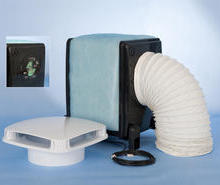
Benefits
The Homevent unit runs continuously except when the loft temperature rises above 25°C when the unit will switch off. This is as the hot incoming air would be uncomfortable. When the air temperature falls below 25°C, the unit will switch back on.
To help keep your home condensation free:
To improve the comfort of the incoming air there is an integral “intelligent low temperature” comfort heater* in the unit.
*This feature employs a sensor, which monitors the incoming air temperature and ensures that when the external temperature drops, the incoming air temperature does not fall below 10ºC.
Controlled by an enable / disable switch located in a convenient position within the property. This energy-efficient heater uses around 7 pence per day. This figure can be further reduced with prudent use, by disabling when the house is empty or other non-critical times.
This preventative measure is better than conducting remedial works to remove the damp. Landlords have a duty under Section 11 of the Landlords and Tenants Act 1985 to ensure properties do not have any mould. The PIV units are a great way to prevent condensation which in turn can lead to mould.
This product is available on https://l-a-b-s.co.uk/product/positive-air-vents-heat-recovery-units/.
The Heat Recovery Unit is special fan which is for single rooms. It has been specifically designed to eliminate excessive moisture. This helps to prevent condensation with the inherent risks to property and health whilst retaining up to 80% of heat contained within the outgoing air. The full range of fan is available here; https://l-a-b-s.co.uk/product/positive-air-vents-heat-recovery-units/.
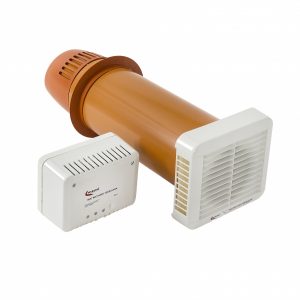
The heat recovery unit range are available in 230v or 12v models which is dependent upon the installation criteria. All the models run on trickle speed continuously and has various options to change to fast speed. The wall mounting kits are available in brown, white, terracotta or stone.
All units are manufactured to create a balanced airflow. This is make sure that there is no interference with the conventional gas boilers / heating systems. This causes negative air pressure which may cause a problem.
Water is deposited on the cooler surfaces in a building, particularly in winter. The first indication is usually black mould growth in the worst affected areas. This growth is characteristic of condensation because mould need pure water for their growth and development. In severe cases the amount of water may be great causing pools of water on the floor, windowsills or on clothing and furniture.
Householders often find it difficult to believe that such severe damp problems can be caused by condensation alone. Often they believe there must be some sort of building defect which is usually not the case.
Often the condensation can occur at low levels where the surface of the wall is coolest, starting in a corner and then spreading along the length of the wall. This may appear to be rising damp and can easily be confused.
If the water vapour in the air of a home can escape somewhere, condensation would never occur. When homes were more draughty and open fires common, damp air would mainly escape up the chimney. Houses are now significantly better insulated hence the moisture has nowhere to go and hence condensation problems have grown significantly.
Mould growth is a typical consequence of condensation problems in a home. Moulds are often most severe in room corners and on external walls. This is mainly because insufficient ventilation creates pockets of stagnant air in such corners.
LABS supplies damp proof materials for surface treatments on damp properties. The range of products are for specialist remedial treatments and general building products. We believe every builder should carry the products with them because of the solution which can be given to the problem.
Technoseal DPM
One of top damp proof materials available as damp proofing surface treatment is the Technoseal DPM. This product is a SBR latex based liquid damp proofing paint for water proofing applications. When the paint dries, a tough semi-gloss finish with a water barrier is made. When the Technoseal DPM can be applied under external rendering or on internal plasterwork. LABS believe that no builder should be without one in their van because of to the versatility of this product.
Dryseal and Enviroseal
Wykamol supplies a masonry protection range includes Enviroseal and a new product to the market DRYSEAL which is their most advanced masonry protection product to date. Both products are highly effective, Enviroseal has been an industry benchmark for many years. The Dryseal provides 15mm of protection against water penetration, this has built on the 2mm with the Enviroseal.
Microsealer and Technocryl 2001
The Wykamol range of floor coatings and additives includes Microsealer which is supplied by LABS. The products in this range proved a highly penetrative solution. Products like the Microsealer is designed chemically to react with hydrated cement. The chemical reaction can take place at the surface and to a depth up to 15 mm. The Silicate active ingredients form monolithic structures within the concrete which are long-lasting and durable and will improve surface wear characteristics. Technocryl 2001 is a cement additive designed for producing heavy industrial and agricultural floors, bedding grouts for machinery and repair mortars. Inside areas of continuous or intermittent water contact, the Technocryl 2001 can be applied internally and externally.
Epoxy Floor Covering
The Wykamol range of Epoxy Floor Coatings are easy to use. The coatings provides an excellent finish to concrete floors giving a hard wearing and dust free floor.
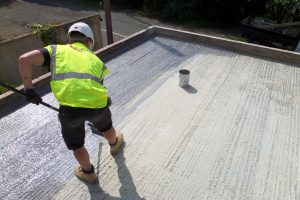
Roof-sealer Plus is a one component, UV Stable, solvent based multi-purpose roof coating Membrane.The Roof-sealer is manufactured with fibre reinforcement pre-dispersed in the can for easy application.
Wykamol’s Masonry Biocides are industry leading products designed to treat masonry brickwork for Dry Rot, moulds, mosses, algae and lichen.
All the products are supplied by LABS via the online shop at www.l-a-b-s.co.uk or at the Damp Shop at 66 Crookes Road, Sheffield, S10 1UG.
Basements are a great option when landlords are looking to add extra value to a rental property. Landlords should look at a number of different variables before committing a conversion conversion. Adding more bedrooms could be beneficial. Landlords should consider Article 4 and HMO Licensing restrictions. Landlords should always consult with your local HMO office and look at planning guidelines.
Maybe landlords might want to reconfigure a house to create more communal space. This could include an extra kitchen, a bathroom, a games room or a whole self contained apartment. You should consult a planning specialist in order to discover whether or not it is achievable.
Some of the properties in the more common student areas in Sheffield have big basements. The biggest ones could have up to 1000 square feet available to convert. This could lead to adding multiple rooms like bathrooms, living rooms, kitchens and bedrooms. If three bedrooms are added at £90 per person, charged weekly. Over a course of a year that could be an extra £14,040. There is potential for any cash investment to be paid off in about 5 years cost the costs of the conversion.
If the lighting requirements for a basement are not ideal, you could consider forming a gym or a games room instead as an alternative as space is not being used as habitable space. In a property with shared accommodation like a student let, this could be the difference between getting the room let. There is potential to increase the rental in order to accommodate the spend on this new usable space. Consideration still must be given regarding building regulations and local authority planning permission.
Many of the new purpose built student properties near to the university have great unique selling points like a games room. With the changes to the property market. It is always good to be ahead of the competition as landlords are providing a service. It is important to provide a positive student experience in order to gain positive reviews.
LABS is looking to offer advice on damp proofing in this post. When the customer’s property has an issue with damp. There are many solutions to resolve the initial issue with damp entering the property, there is an importance to discover the source of the damp issue. This page describes the different types of damps; https://l-a-b-s.co.uk/damp-proofing-sheffield/.
Once the source of damp is discovered. Here we offer advice on damp proofing solutions for the common damp problems encountered over the years.
Rising Damp
Rising damp usually comes up through the masonry from the ground because of hydrostatic pressure. Usually any internal plaster work in most cases would be removed to about 1200mm. The recommended treatment is to drill and injection the damp proofing cream (DPC). The DPC should be injected above the damp proof membrane (DPM), engineering bricks or the joists. Some older properties might not have a DPM or engineering bricks ideally from internally and externally. LABS would look to install a plastic membrane on to the wall which is fixed to the wall by special plugs. The plasterer would then replace the plasterwork to the original condition along with the replacement of any fixings and fixtures.
Penetrating Damp
Penetrating damp usually occurs when external waters damages the outside of a property. The moisture breaches the wall into the property. The penetration of the wall can take place at many parts of the wall. The recommendation in this instance is to remove the plaster. The wall should be fully back to brick. A full wall height of plastic membrane with mesh would be installed. Followed by the insertation of the plug and seal to the wall. The plasterer would then replace the plasterwork to the original condition along with the replacement of any fixings and fixtures.
Chemical (Salt) Damp
Chemical damp is usually formed with nitrates from an area of the wall following a reaction from the contaminated plasterboard. This affected area draws moisture from the air as a form energy for the damp. The affected plasterwork will need to be removed. In some case salt neutralisers can be used to correct the masonry of the salt build up. However, it is generally recommended that the wall is strip back to brick and a plastic membrane is applied to the wall. The membrane will be fastened with plugs and seals.
Condensation Damp
Condensation damp usually arises from moisture laden air hitting a colder surface. Usually the prevention is easy than the cure of applying a plastic wall membrane. We would recommend using a specialist heat exchange fan unit like the ones in our range https://l-a-b-s.co.uk/product/positive-air-vents-heat-recovery-units/. This will remove up to 80% of the moisture laden air and replace with warmer moisture free air.
LABS as a Wykamol Approved Contractor offers Insurance Backed Guarantee. We can give you the peace of mind that when you request one. When we contact, we will be able to offer you a guarantee from CGS.
Sticking a pin into a phone book gives you a more limited chance of finding a contractor good enough to be backed by an insurance company authorised and regulated by the FSA.
However if you choose not to gamble with your house and you prefer competence over amateurs. Then you should to choose LABS as a CGS Approved Contractor. LABS is also a member of the Basement Waterproofing Association. CGS offer insured guarantees with the insurance certificate specific to your property and issued by an FSA authorised and regulated UK insurance company. 70% of all companies go out of business within 10 years and though CGS contractors are considerably below the national average because of the quality of the contractors allowed into membership, for a very small one-off premium usually between 5-8% of the agreed amount for works. You can insure against even this eventuality.
Warning: some companies offer “Insurance Backed Guarantees” but all this indicates is an annual insurance by the guarantee company, with the insurance in the name of that company not your house and if it is not paid annually then it collapses.
LABS would like to offer some advice when consumers are looking for approved contractors with insurance backed schemes. When comparing quotes, check what you are getting and ask competing contractors which of these they can offer (if any).
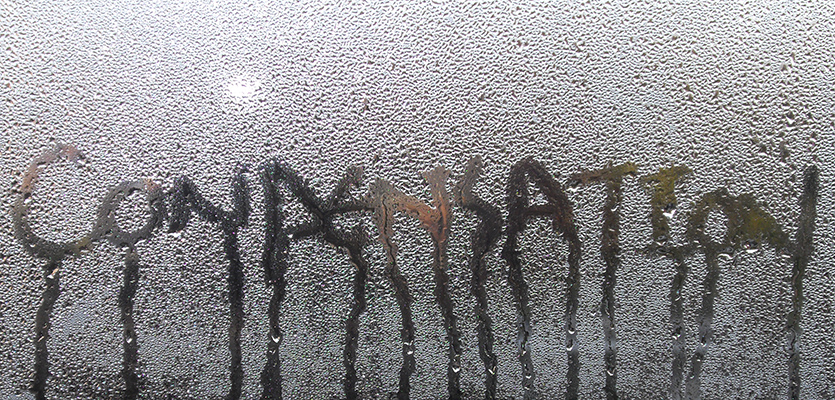
Condensation is the most common form of unwanted dampness in properties. It forms as a result of moisted laden air which hits a cold surface.
The air in buildings can have a high level of relative humidity due to human activity (cooking, drying clothes, breathing and so on). When this water laden air comes into contact with cold surfaces such as windows and cold walls it can condense, causing water to be deposited. The point at which the water held in the air changes form vapour to liquid is known as the ‘dew point’.
Condensation is often associated with poor heating and ventilation in buildings, but this simple view can be misleading. Condensation is chiefly a winter problem, the external air temperature is low and external walls and windows are cold. The usual sequence of events is as follows:
Walls in kitchens and bathrooms (where atmospheric moisture levels are usually highest), solid external walls, un-insulated solid floors and cold bridges such as concrete lintels set in cavity walls are commonly the areas in which condensation takes place.
Intermittent heating and cooling of the property can aggravate condensation problems, since it allows warm damp air to cool, reducing its capacity to hold water. Dew points are reduced allowing condensation to occur. When the air is reheated water is taken back into the air only to be deposited again when the air temperature drops again.
Running water on windows and walls is perhaps the most immediate indication of a condensation problem. If ignored this can lead to a deterioration in the decorative condition of the property, stained curtains and decay in window frames. The appearance of moulds on the surface of wallpapers and paints in poorly ventilated areas. Condensation can occur under suspended floors greatly increasing the chances of a fungal decay in floor timbers.
A much less common form of condensation occurs when the dew point is reached, not on the surface of a wall but within the structure of the building itself. This is known as interstitial condensation and can easily be mistaken for rising or penetrating damp.
Preventing / Treating Condensation
Condensation is a real problem and where it persists LABS as a specialist surveyor should be engaged to explore the cause of the problem and provide advice or propose solutions. We have listed just a few of the possible methods of controlling condensation below.
Simply heating the air is unlikely to be a satisfactory solution, not only on grounds of cost, but also of practicality. Unless cold surfaces are eliminated, condensation is almost inevitable. Any remedial action, therefore, must involve both a lowering of moisture levels and the elimination of cold surfaces.
Improved heating and ventilation coupled with specific action in relation to cold spots will usually result in a significant improvement in conditions, although there may be circumstances in which alternative methods are required. A modest but constant background heat is preferable to intermittent heating since this will help to maintain a higher ambient temperature in the fabric of the building.
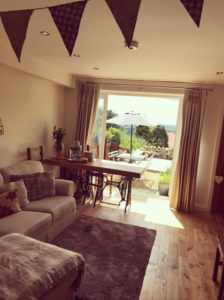 When looking at a basement conversion, you must think firstly that each project is different.
When looking at a basement conversion, you must think firstly that each project is different.
In some cases, creating a space underneath the existing building is the only way to increase the usable square footage of the building. This is one of the reasons why basement conversions are so popular in central London, where opportunities for above-ground alterations are minimal.
Besides adding usable space to your home, a basement conversion can help to significantly increase the value of your house.
Depending on the area, factors like access, available headroom, and the potential for natural light can significantly affect the value per square metre of a basement conversion.
In some areas, there is considered to be a ‘ceiling’ value for property prices. No matter how beautifully converted your basement, is hard to surpass.
It can be worth consulting a local estate agent for their opinion before making hard and fast decisions regarding the nature of the basement development to undertake. Some property experts suggests that the right basement in the right area can add up to 20% to the property market value.
Factors affecting cost
A basement conversion will always work out cheaper if there is no excavation required – either to create the underground space from scratch or increase the headroom in an existing basement. Difficulties with excavation can include:
Costs for basement work can vary significantly depending on the jobs to be undertaken
An idea of the costs involved:
Before you embark on your basement project ensure you take all of these factors into consideration to make your investment worthwhile.
By Basement Waterproofing Association
LABS are Gold Members of the Basement Waterproofing Association
For any further information, contact LABS under contact https://l-a-b-s.co.uk/contact/